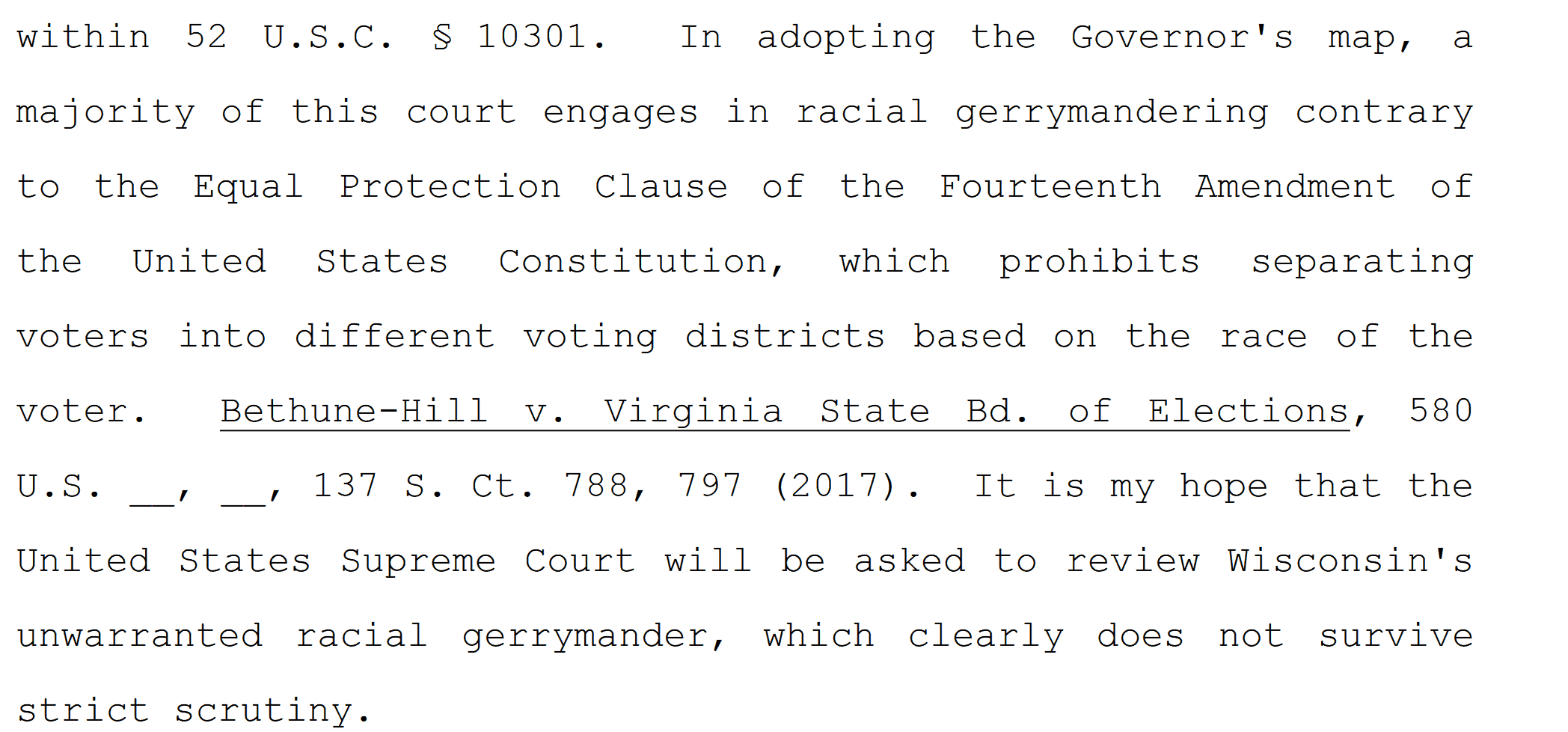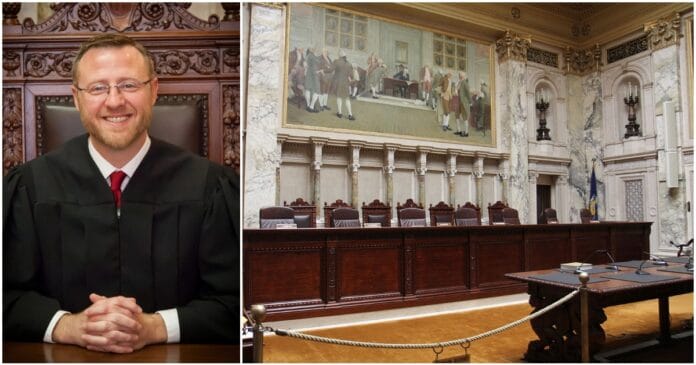“In adopting the Governor’s map, a majority of this court engages in racial gerrymandering contrary to the Equal Protection Clause of the Fourteenth Amendment of the United States Constitution, which prohibits separating voters into different voting districts based on the race of the voter,” –Wisconsin Supreme Court Justice Roggensack
Wisconsin Supreme Court Justice Brian Hagedorn, who convinced voters he was a conservative when he ran for the seat, has authored a majority opinion that adopts Gov. Tony Evers’ legislative maps and Congressional district boundaries. In a sharply worded dissent, conservative justices called the decision unconstitutional racial gerrymandering, noting, “It is beyond dispute that the Governor’s districting plan adopted by a majority of this court assigns voters to districts based on race.”
The decision will make it harder for Republicans to keep two key Congressional districts.
Chief Justice Annette Ziegler, a conservative, wrote, “I dissent because here, the majority’s decision to select Governor Tony Evers’ maps is an exercise of judicial activism, untethered to evidence, precedent, the Wisconsin Constitution, and basic principles of equal protection.”
Ziegler found that the Governor has not demonstrated a Voting Rights Act violation, so “there can be no race–based remedy, let alone one constructing a new district and changing six others in Milwaukee to include exactly 51% black populations.”
Yet that’s what occurred.
Wisconsin Redistricting Map Decision
The 4-3 decision came down from the Wisconsin Supreme Court on March 3, 2022. Hagedorn, who has also been a thorn in Republicans’ side on election issues, sided with the liberals on the court. Siding with Hagedorn were liberal Justices Ann Walsh Bradley, Rebecca Dallet and Jill Karofsky.
The Milwaukee Journal Sentinel and other liberal media outlets buried conservative justices’ withering dissents and argued that the new maps still tilt the Legislature Republican because the court was following a November decision to make the least changes from the 2011 redistricting maps, which were controlled by Republicans in the Legislature. That means that the court has approved GOP majority maps for the next decade.
At the same time, the newspaper noted that, in the Congressional races, Evers’ maps will make it harder for Republican U.S. Rep. Bryan Steil to win re-election, because his district “will now lean Republican by about two points, or eight fewer than its current lean.” The newspaper also admitted that the Evers’ maps will keep outgoing Democratic U.S. Rep. Ron Kind’s district competitive by rejecting Republican maps that would have made it solidly Republican.
Some Republican state legislative districts may also be at risk.
Evers created a People’s Maps Commission to draw its own legislative districts after the 2020 Census as a counterpoint to those drawn by the Republican-controlled Legislature. Republicans suspected from the start that this was an unconstitutional attempt by the governor to usurp the Legislature’s authority to draw boundaries and give more of an edge to Democrats. The Commission was criticized for a lack of transparency to the public.
According to the dissent by conservative Justice Pat Roggensack, the Hagedorn-led majority “assigns voters based solely on their race to create seven majority–minority voting assembly districts in Milwaukee County.” Roggensack noted, “It is my hope that the United States Supreme Court will be asked to review Wisconsin’s unwarranted racial gerrymander, which clearly does not survive strict scrutiny.”
Among other changes, Evers’ maps create a seventh majority black state Assembly district in the Milwaukee area. The Court disregarded concerns that Evers’ maps make “gratuitous” and unexplained changes to other districts. How maps are drawn can change the balance of power between political parties in the state Legislature, which is controlled by Republicans, and Congressional districts.
“In adopting the Governor’s map, a majority of this court engages in racial gerrymandering contrary to the Equal Protection Clause of the Fourteenth Amendment of the United States Constitution, which prohibits separating voters into different voting districts based on the race of the voter,” Roggensack wrote. Roggensack’s dissent was joined by the other conservative justices on the Wisconsin Supreme Court: Chief Justice Annette Ziegler and Justice Rebecca Bradley.
In her own dissent, Bradley wrote, “Now, the majority overrides the United States Constitution, the Wisconsin Constitution, and federal statutory law…The majority’s decision represents a startling departure from the rule of law and an alarming affront to the people of Wisconsin who elected us to uphold the constitutions.”
Ziegler wrote, “The majority opinion demonstrates a complete lack of regard for the Wisconsin Constitution and the Equal Protection Clause.” Ziegler wrote that the court “should have adopted the maps submitted by the Wisconsin Legislature…and Congressmen Glenn Grothman, Mike Gallagher, Bryan Steil, Tom Tiffany, and Scott Fitzgerald.”

Roggensack’s dissent noted that Wisconsin has “had significant experience with electing black candidates through white crossover voting,” citing as one of several examples Congresswoman Gwen Moore, who is black, and who received 76.74% of the vote in a district that is only 33.3% black.
“The majority opinion identifies no compelling state interest to which its racial gerrymander is narrowly tailored,” wrote Roggensack.
Just as I predicted. Brian Hagedorn is the best friend Wisconsin Democrats have. https://t.co/UnpY4w6X9E
— SarahAnnRhoades (@SarahAnnRhoades) March 3, 2022
Read the decision in full here.
Bradley wrote, “Not only does the majority adopt an assembly map and a congressional map with unconstitutional population deviations, it also inflicts a constitutional harm not present in the 2011 maps by severing the boundaries of numerous local communities with no lawful justification for doing so.“
She added, “Expanding the number of Black opportunity districts to seven may on the surface appear to augment Black voting strength, but in reality it jeopardizes the effectiveness of each district by spreading the population too thin, with each of the Governor’s opportunity districts hovering just above or just below 50%.”
According to Bradley, “problematically, the majority seems to sanction an illegal map——
containing an unlawful number of splits——because the map performs well on a single extra–legal criterion, core retention. The majority’s approach violates its duty to uphold the
Wisconsin Constitution.”
According to the Hagedorn decision, opponents argued that Evers’ proposal makes unexplained “gratuitous changes,” for example swapping communities between congressional districts 4 and 1.
The court ruled that nothing in its prior orders required an explanation of changes “at any level of granularity.”
Hagedorn noted in the decision that, every 10 years, states “are required to redraw the boundaries for congressional and legislative districts to account for population changes. This means the maps enacted into law in 2011 cannot constitutionally serve as the basis for future elections. The responsibility to adopt new district boundaries is not ours in the first instance, but that of the legislature and governor via the legislative process.”
Hagedorn slammed politicians, writing, “We have given the political branches a fair opportunity to carry out their constitutional responsibilities. They have not done so.”
Hagedorn noted that the Court did not want to draw its own maps. Instead, justices asked each side to submit maps that they considered against changes to state law.
Hagedorn admitted that the Evers’ maps are not perfect, saying, “We must acknowledge that each proposal makes changes that appear unnecessary to account for population changes or to otherwise comply with the law,” he wrote.
 Loading...
Loading...
According to the Wisconsin redistricting map decision, the Supreme Court received Congressional maps from four parties, including Evers.
On Congressional maps, Hagedorn wrote: “The first question is which map most complies with our least-change directive. With only eight districts, core retention——a measure of voters who remain in their prior districts——is the best metric of least change, and the map submitted by Governor Evers easily scores highest. His map moves 5.5% of the population to new districts, leaving 94.5% in their current districts. In raw numbers, the Governor’s proposal to move 324,415 people to new districts is 60,041 fewer people than the next best proposal. In addition, Governor Evers’ submission complies with the federal Constitution and all other applicable laws. We therefore adopt Governor Evers’ proposed congressional map.”
On the state legislative maps, he wrote that the Court received six map proposals.
Wrote Hagedorn, “The proposed senate and assembly maps making the least changes from current law are once again those of Governor Evers. In their senate proposals, both Governor Evers and the Legislature move a nearly identical 7.8% of voters to different districts (92.2% core retention), with a slight edge to the Legislature for moving 1,958 fewer people. However, in their assembly map proposals, Governor Evers moves 14.2% of voters to new districts, while the Legislature moves 15.8% (85.8% vs. 84.2% core retention), a difference that affects 96,178 people. No other proposal comes close.”
He added, “We also conclude that Governor Evers’ proposals satisfy the requirements of the state and federal constitutions. Under the Wisconsin Constitution, all districts are contiguous, sufficiently equal in population, sufficiently compact, appropriately nested, and pay due respect to local boundaries. Governor Evers’ proposed maps also comply with the federal constitution’s population equality requirement.”
Table of Contents





















![WATCH: Elon Musk Town Hall Rally in Green Bay [FULL Video]](https://www.wisconsinrightnow.com/wp-content/uploads/2022/04/Elon_Musk_3018710552-356x220.jpg)











